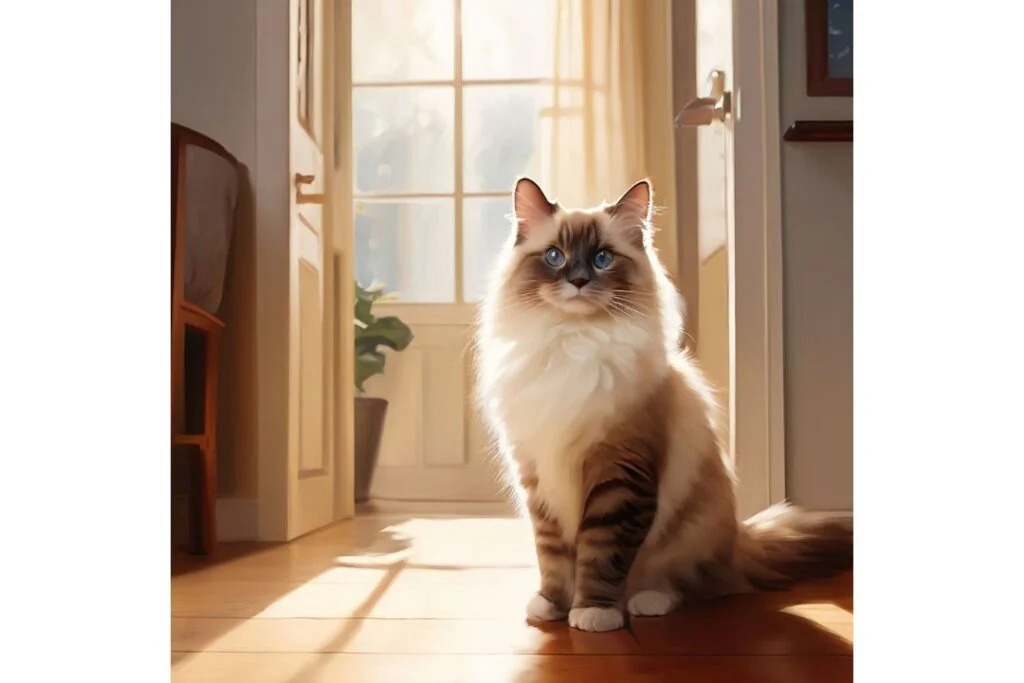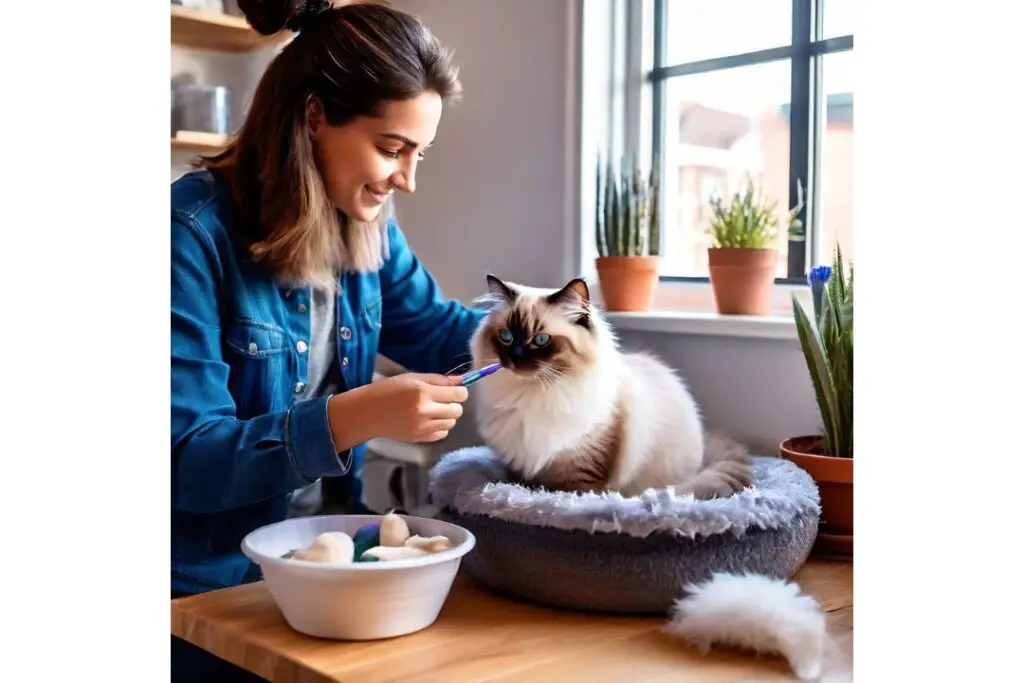Ragdoll cats – the very name evokes images of a plush, floppy feline companion that seems to melt into your arms. But have you ever stopped to wonder Why Are Ragdoll Cats Called Ragdolls? In this blog post, we will delve into the origins of this unique breed’s name, uncovering the fascinating history and lore behind these captivating cats.
The Origins of the Ragdoll Name
The story of how Ragdoll cats acquired their distinctive name is as intriguing as the breed itself. Legend has it that in the 1960s, a strikingly beautiful white cat named Josephine, believed to be a mix of Persian, Siamese, and Birman ancestry, caught the eye of Ann Baker, a dedicated cat enthusiast. Josephine’s gentle, affectionate nature and striking appearance inspired Ann to embark on a breeding program to perpetuate these desirable traits.
As Ann meticulously bred Josephine with other carefully selected cats, distinctive features such as striking blue eyes, a semi-longhaired coat, and a laid-back, docile temperament began to manifest in her offspring. The resulting kittens were so docile and relaxed that they would go limp in the arms of whoever held them, earning them the endearing nickname “Ragdolls.”
The Temperament of Ragdoll Cats

One of the defining characteristics of Ragdoll cats is their incredibly laid-back and relaxed temperament. These gentle giants are known for their affectionate nature and love of human companionship, making them ideal pets for families, singles, and seniors alike. Ragdolls are often described as “dog-like” in their behavior, following their owners from room to room, seeking out attention, and even playing fetch with beloved toys.
Despite their large size, Ragdolls have a reputation for being remarkably gentle and tolerant, making them excellent companions for children and other pets. These cats are not prone to aggression and are known for their adaptability to various environments and living situations. Ragdolls thrive on human interaction and are happiest when curled up in their favorite human’s lap, purring contentedly.
The Physical Characteristics of Ragdoll Cats
In addition to their charming temperament, Ragdoll cats possess striking physical features that set them apart from other breeds. These cats have medium to long fur that is soft and silky to the touch, with a luxurious coat that comes in a variety of colors and patterns, including seal, blue, chocolate, and lilac, as well as colorpoint, mitted, and bicolor markings.
Ragdolls are known for their dazzling blue eyes, which are large, almond-shaped, and expressive, adding to their captivating allure. Their bodies are well-built and muscular, with round faces, prominent cheekbones, and tufted ears that give them a regal appearance. Ragdolls typically have a pointed color pattern, with darker markings on their ears, face, paws, and tail, creating a striking contrast against their lighter body color.
The Mythology and Magic of Ragdoll Cats
In ancient folklore and mythology, cats have always held a special place as mystical and enigmatic creatures with otherworldly powers. Ragdoll cats are no exception, with their ethereal beauty and enchanting presence inspiring tales of magic and wonder. In some cultures, cats are believed to possess healing powers, wisdom, and the ability to see beyond the veil of reality.
Ragdolls, with their serene demeanor and soulful gazes, seem to embody the essence of these mythical felines, instilling a sense of awe and reverence in those who encounter them. Some believe that Ragdoll cats are harbingers of good luck, bringing positive energy and protection to their human companions. Whether or not you believe in the supernatural, there is no denying the magnetic charm and allure of these captivating creatures.
Caring for Your Ragdoll Companion

As devoted cat lovers, it is essential to provide your Ragdoll companion with the care and attention they deserve to thrive and flourish. Ragdolls require regular grooming to keep their plush coats free of tangles and mats, as well as a balanced diet rich in protein, vitamins, and minerals to maintain their overall health and vitality.
Make sure to provide your Ragdoll cat with plenty of mental stimulation and interactive play to satisfy their curious nature and prevent boredom. Investing in quality toys, scratching posts, and climbing structures will keep your Ragdoll entertained and engaged, preventing destructive behaviors such as scratching furniture or overeating.
Creating a safe and enriching environment for your Ragdoll cat, complete with cozy beds, sunny windowsills, and engaging toys, will ensure their physical and emotional well-being. By nurturing a strong bond with your Ragdoll companion through regular play, grooming, and affectionate interactions, you will forge a lifelong connection based on trust, love, and mutual respect.
“Why Are Ragdoll Cats So Expensive? 5 Reasons Behind the High Costs”
Do Ragdoll Cats Like Water? Myth vs. Reality
Conclusion: Why Are Ragdoll Cats Called Ragdolls

In conclusion, the enchanting allure of Ragdoll cats goes beyond their striking physical appearance and endearing temperament. These magical creatures embody the timeless mystique of felines, captivating us with their grace, wisdom, and unspoken communication. Whether you are a seasoned cat lover or a newcomer to the world of feline companionship, Ragdoll cats have a way of touching our hearts and souls, leaving an indelible imprint on our lives.
So, the next time you hold a Ragdoll cat in your arms and feel their warm, comforting weight against your chest, remember the fascinating history and mythology behind their name. Ragdolls are more than just pets – they are cherished companions, loyal friends, and beloved family members who bring joy, laughter, and love into our lives. In a world filled with chaos and uncertainty, Ragdoll cats offer us a glimpse of magic, beauty, and wonder, reminding us of the profound connection between humans and animals that enriches our existence. Embrace the magic of Ragdoll cats and let their enchanting presence fill your heart with love and light.
FAQs About Ragdoll Cats
1. What makes Ragdoll cats unique?
Ragdoll cats are known for their incredibly laid-back temperament and affectionate nature. They are often described as “dog-like” because they tend to follow their owners around, seek attention, and even enjoy playing fetch. Additionally, their tendency to go limp when picked up, resembling a ragdoll, is a distinctive trait that sets them apart.
2. How did Ragdoll cats get their name?
The name “Ragdoll” originates from the 1960s, when Ann Baker, a cat breeder, noticed that the kittens from a beautiful white cat named Josephine would go limp and relaxed when held. This endearing behavior led to the nickname “Ragdolls,” which perfectly captured their docile nature.
3. What are the key physical characteristics of Ragdoll cats?
Ragdoll cats have medium to long, silky fur that comes in various colors and patterns, such as seal, blue, chocolate, and lilac. They have large, expressive blue eyes, round faces, prominent cheekbones, and tufted ears. Their well-built, muscular bodies often exhibit a pointed color pattern, with darker markings on the ears, face, paws, and tail.
4. Are Ragdoll cats good for families?
Yes, Ragdoll cats are excellent family pets. Their gentle and tolerant nature makes them great companions for children and other pets. They are not prone to aggression and adapt well to various living environments, thriving on human interaction and affection.
5. Do Ragdoll cats require special care?
Ragdoll cats need regular grooming to keep their plush coats free of tangles and mats. They also require a balanced diet rich in protein, vitamins, and minerals. Providing them with mental stimulation and interactive play is essential to keep them engaged and prevent boredom.
6. How should I groom my Ragdoll cat?
To maintain their luxurious coat, brush your Ragdoll cat at least twice a week to prevent tangles and mats. Regular grooming also helps reduce shedding and keeps their fur healthy. Occasional baths can help keep their coat clean, but Ragdolls generally groom themselves well.
7. What type of diet is best for Ragdoll cats?
Ragdoll cats thrive on a high-quality diet that includes plenty of protein, vitamins, and minerals. Consult your veterinarian for specific dietary recommendations based on your cat’s age, health, and activity level. Fresh water should always be available.
8. Are Ragdoll cats prone to any health issues?
While Ragdoll cats are generally healthy, they can be prone to certain genetic conditions such as hypertrophic cardiomyopathy (HCM) and polycystic kidney disease (PKD). Regular veterinary check-ups and screenings can help detect and manage these conditions early.
9. How do I keep my Ragdoll cat entertained?

Invest in a variety of toys, scratching posts, and climbing structures to keep your Ragdoll cat entertained. Interactive play sessions and puzzle toys can help stimulate their minds and prevent boredom. Ragdolls also enjoy spending time with their human companions, so regular interaction is key.
10. Can Ragdoll cats be left alone for long periods?
Ragdoll cats are social creatures and prefer human companionship. While they can tolerate being alone for short periods, it’s not advisable to leave them alone for extended periods. If you need to be away, consider arranging for someone to check in on them or providing interactive toys to keep them occupied.
11. Do Ragdoll cats get along with other pets?
Yes, Ragdoll cats typically get along well with other pets due to their gentle and non-aggressive nature. They are known for their adaptability and can form strong bonds with both dogs and other cats.
12. How do Ragdoll cats communicate?
Ragdoll cats are known for their soft, quiet voices. They communicate through a combination of meows, purrs, and body language. They may gently paw at you or follow you around to signal they want attention or playtime.
13. Are Ragdoll cats hypoallergenic?
No, Ragdoll cats are not hypoallergenic. They produce allergens like other cats, and their long fur can trap more dander. However, regular grooming and maintaining a clean living environment can help reduce allergen levels.
14. How big do Ragdoll cats get?
Ragdoll cats are one of the larger cat breeds. Adult males typically weigh between 15-20 pounds, while females weigh between 10-15 pounds. They have a sturdy, muscular build and can take up to four years to reach their full size.
15. What is the lifespan of a Ragdoll cat?
With proper care, Ragdoll cats can live between 12-15 years or even longer. Providing a nutritious diet, regular veterinary care, and a loving home can contribute to a long and healthy life for your Ragdoll companion.
16. Do Ragdoll cats enjoy being held?
Yes, most Ragdoll cats enjoy being held and cuddled. Their relaxed and affectionate nature makes them ideal lap cats. However, as with any pet, individual preferences can vary, so always pay attention to your cat’s comfort and signals.
17. What should I consider before getting a Ragdoll cat?
Before getting a Ragdoll cat, consider the time and commitment required for grooming, play, and social interaction. Ensure you have a safe and enriching environment for them and be prepared for regular veterinary care to keep them healthy.
By understanding the unique characteristics and needs of Ragdoll cats, you can provide a loving and fulfilling home for these enchanting companions, ensuring they thrive and bring joy to your life.

